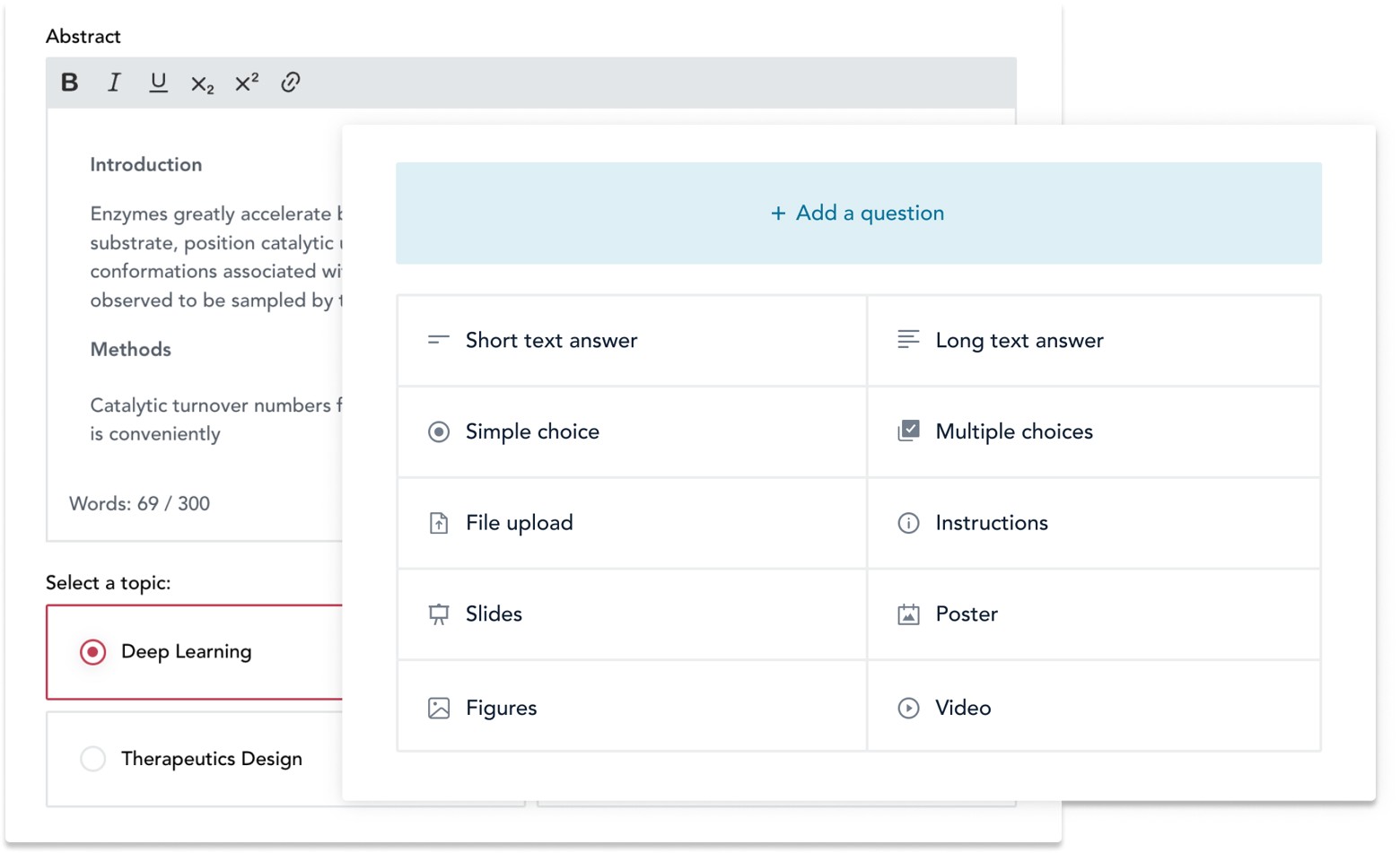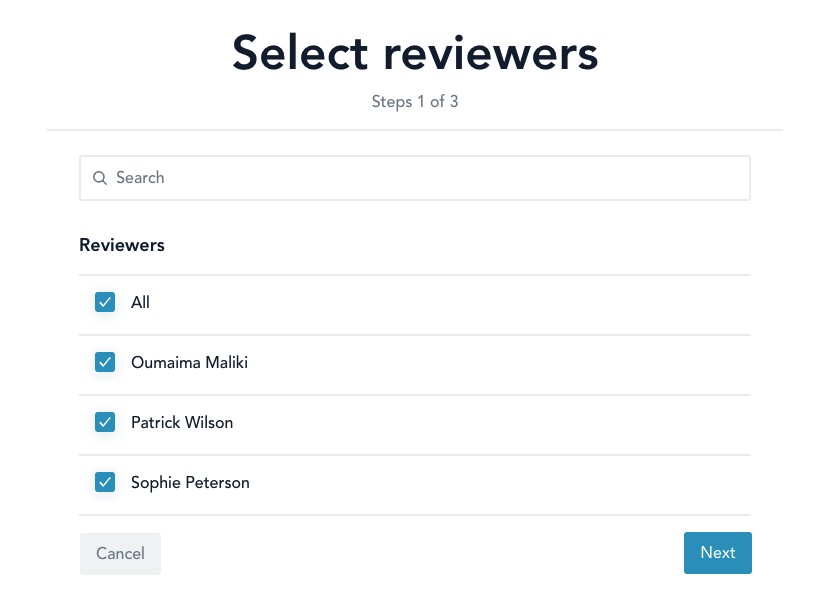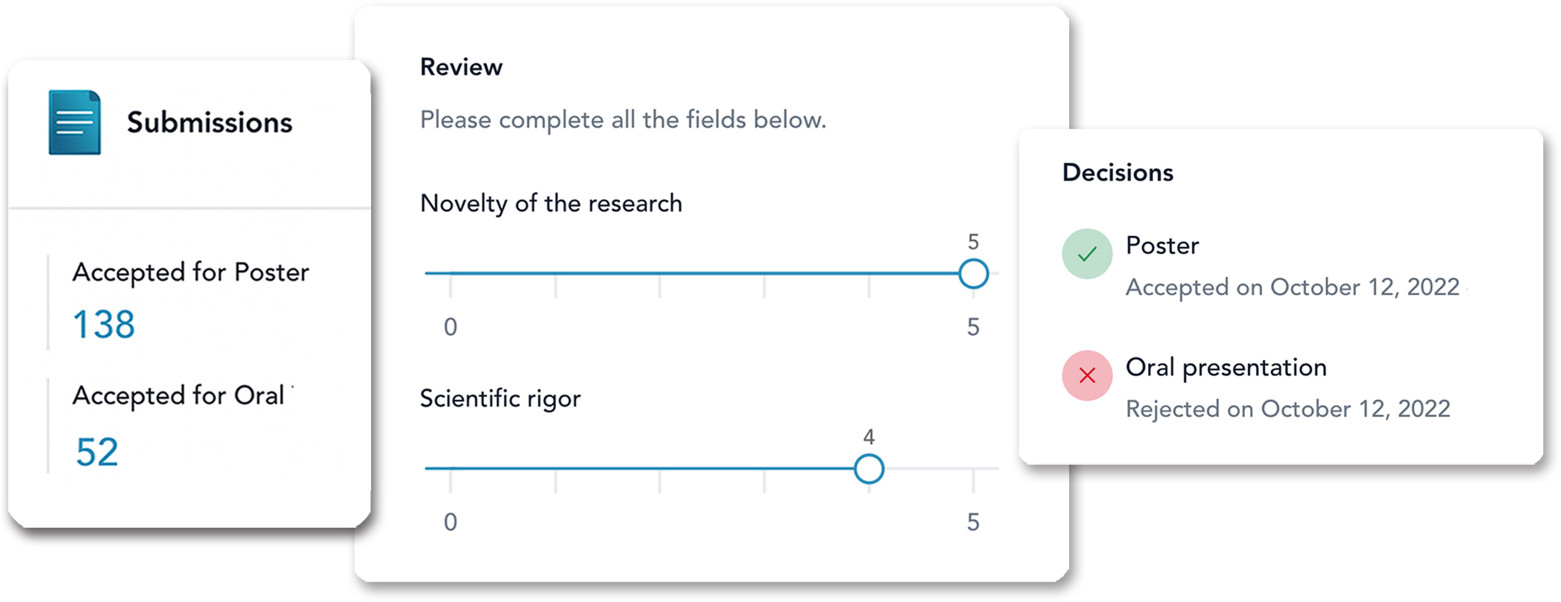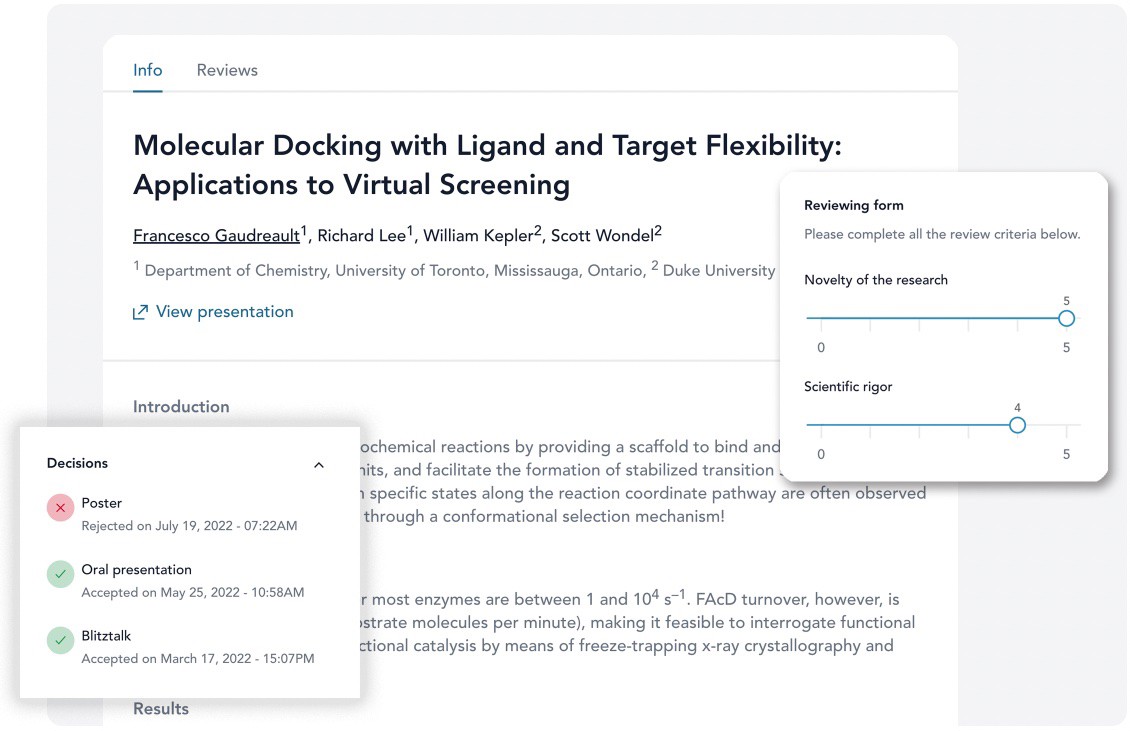Your Guide to the Conference Peer Review Process
Research conferences serve as a pivotal platform for the scientific community to share and improve their research. Ensuring the validity and quality of the presented studies is crucial to the success of an event, and the peer review process plays an important role in this.
Planning a scientific conference is no small feat, especially when it comes to managing peer review. Throughout this process, conference peer review software can ease the burden and make mundane tasks (like managing submissions and assigning reviewers) a breeze.

What is peer review?
In general, the peer-review process subjects an author's research to the scrutiny of subject matter experts (peers) and is considered necessary to ensure academic scientific quality and enable said research to be published in different journal articles. Academic journal editors or editorial boards from scientific journals will use peer reviews from the research community to assess the quality of research articles.
Peer review, in the context of research conferences, refers to the evaluation and assessment of submitted research papers or presentation proposals by experts in the relevant field.
The aim of the peer review process is to ensure that the submitted research is original, methodologically sound, and contributes constructively to the body of work and theme of the conference. More than a gatekeeping tool, peer review serves to augment the quality of presentations and safeguard the credibility of a conference. If you’re still not convinced on the value of it, read more about why conference papers should be peer reviewed.
Common types of peer review
So, peer review is all about having experts take a magnifying glass to research proposals or papers, ensuring they’re top-notch, reliable, and a brilliant addition to your conference. But, there’s more than one way to run a smooth peer review process. Read more about the most common types of peer review.
-
Single-blind peer review
In a single-blind peer review process, the reviewers are aware of the authors' identities, but the authors are unaware of the names of the reviewers. This traditional model, while sometimes criticized for potential bias, is often appreciated for its straightforwardness. If you’re using single-blind review, you’ll want to be extra careful to avoid nepotism while assigning reviewers.
-
Double-blind peer review
The double-blind review process conceals the identity of both authors and reviewers, fostering a more unbiased assessment process, and less conflicts of interest. However, completely anonymizing submissions can sometimes be a challenging endeavor. Since reviewers and authors often work within the same field, clues within the research methods or results can sometimes give clues to reviewers about the author of the paper they’re reviewing.
-
Open peer review
An open peer review process embodies transparency by revealing the identities of both authors and reviewers, fostering an open dialogue and collaboration amidst all parties involved. This peer review model is encouraged for conferences where reviewers want to be highly involved and are happy to provide constructive feedback and revisions to the author in person as well.
Key steps in the conference peer review process
The peer review process at a research conference is a bit different than the process for accepting submissions to journals. It’s also, usually, far less rigorous. Here’s some tips for navigating the conference peer review process, step by step!
1) Gathering submissions

Fourwaves customizable submission form - Try it free
This is the starting line for every scientific conference. Collecting and managing research submissions can be a cumbersome task, especially when dealing with heaps of entries (which is a good thing to have!).
During this stage of the peer review process, you’ll need to set up a submission system, launch a call for papers, and promote that call whenever possible. You’ll also need to allow plenty of time for submission and, if possible, a window for authors to make edits to their original submissions (based on research findings that may have changed since they first submitted).
Clearly, it’s a lot to keep track of! Employing peer-review software at this stage can streamline the collection process, ensure data consistency, and make the experience better for authors making submissions to your conference (it doesn’t hurt to make a good first impression).
2) Assigning reviewers

Fourwaves peer-review software - Try it free
At this point in the peer review process, you’ll likely have all your early-stage submissions gathered. Matching all those submissions with reviewers who possess the relevant expertise is the next important step (and it can be a bit of a puzzle).
Just like you gathered submissions, you’ll have to do a bit of outreach to find a group of reviewers that are willing to volunteer their time to review for your conference. Make sure you aren’t cutting corners and overloading a smaller group of reviewers with too many reviews. The quality will drop as a result, and you’re less likely to have reviewers that volunteer to return and help the following year.
After you’ve gathered a large enough group of reviewers, you have the tricky task of pairing them off with submissions that they are best suited to review. Here, peer review software can help by analyzing keywords, topics, and even past review history to suggest suitable reviewer assignments. During this part of the peer review process, ensure that you filter for nepotism.
3) Scoring submissions

Fourwaves peer-review software - Try it free
Once reviewers have been assigned to submissions, you’ll need to provide them with a standardized scoring system that can help them in objectively evaluating the work. Providing an evaluation rulebook helps to keep things fair for authors, regardless of which reviewer is assigned to their submission. It also helps you assess whether certain reviewers' average scores are higher than others - something you can take into consideration when making final decisions on which submissions to accept to your conference.
Scoring submissions is an important part of the abstract management process. So, be sure you’re evaluating submitted research on the following factors at the very least:
- Originality - Does the research add something new or take a unique angle compared to the existing body of knowledge?
- Significance of Findings - Are the findings significant to the existing research?
- Technical Quality - Is the methodology sound and is it presented effectively?
- Relevance to the Theme - Is the research relevant to the topic of the conference?
In this stage of the peer review process, a peer-review system can provide customizable scoring templates or help you keep track of the progress of the reviews. Once all reviews have been submitted, the conference program committee can also use features of peer review software to aid in making final acceptance decisions for the event. They can also wait for authors’ response, further information or minor revisions before accepting the peer-reviewed articles.
4) Notifying authors

Fourwaves peer-review software email feature - Try it free
This is the drumroll moment of the peer review process! Communicating decisions to authors in a timely and organized manner is vital to the reputation of your conference. When reaching out to accepted authors, consider including advice for attending the conference and some guidelines for conference presentations. Also, be sure to include any relevant reviewer comments or feedback that the authors can use to improve their research presentations before the day of the event.
Sending out emails (and making sure they have all the correct information for each author) can be quite a time suck. If you have a small conference team or, like most of us, dread a cluttered inbox, automated notifications and status updates facilitated by peer-review software can simplify this process. It’s the best way to send out timely, organized, and clear communication with minimal hassle in the backend.
With Fourwaves for example, you can send mass-emails with personalized fields like name, submission link, event name and date, etc. No more copy-pasting for an endless list of emails.
How can peer review software help?

Fourwaves peer-review software - Try it free
Imagine having a smart sidekick to help you navigate through the maze that the peer review process can become. Using peer-review software isn’t just a time-saver, it’s your one-stop-shop for managing submissions, assigning reviewers, ensuring blind-reviewing (when applicable), scoring entries, and communication, all while keeping things transparent and organized!
Particularly for larger conferences, where the scale of submissions can be overwhelming, leveraging technology ensures a streamlined review and acceptance stage. With just a little bit of a tech boost, you can elevate the accuracy and efficiency of your peer review process.
Just remember: Each conference is unique, so choosing a review type and software that best fits your needs will lead to a more successful peer review process!
From submission collection to reviews and publication.
The power of peer review: Increase conference credibility
The peer review process, while complex, is fundamental in preserving the quality of scientific conferences. By adopting a structured approach to peer review and taking advantage of well-designed, peer-review software, you can ensure an efficient, transparent, and credible review process at your conference. Embracing user-friendly technology in managing peer review not only simplifies logistical challenges but also improves the reputation of your conference.
An effectively managed peer review process paves the way for scientific advancements and collaborative scholarly engagements. So, let’s continue to hold our conference to a higher standard and make sure every piece of research gets the attention (and the platform) it deserves!

